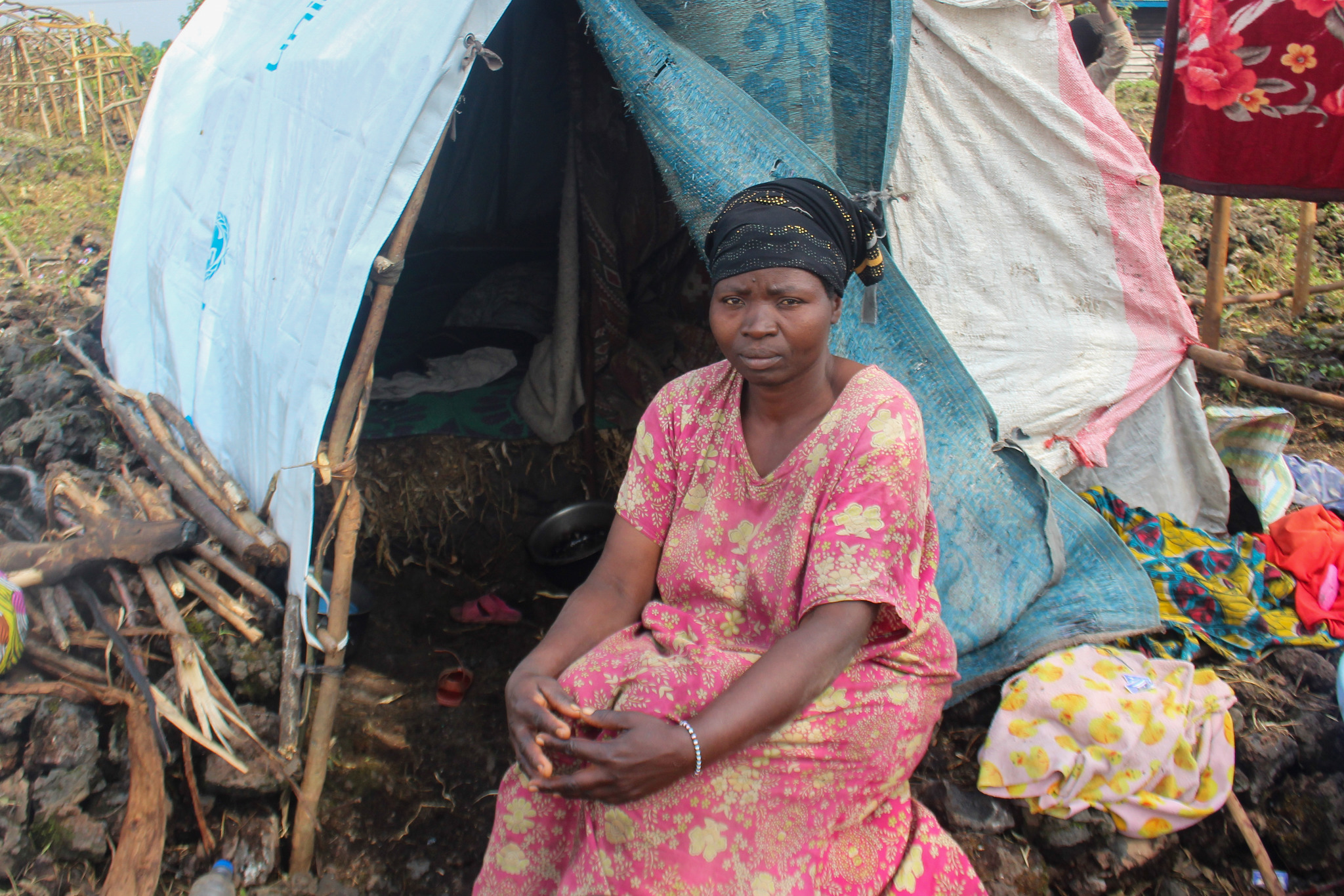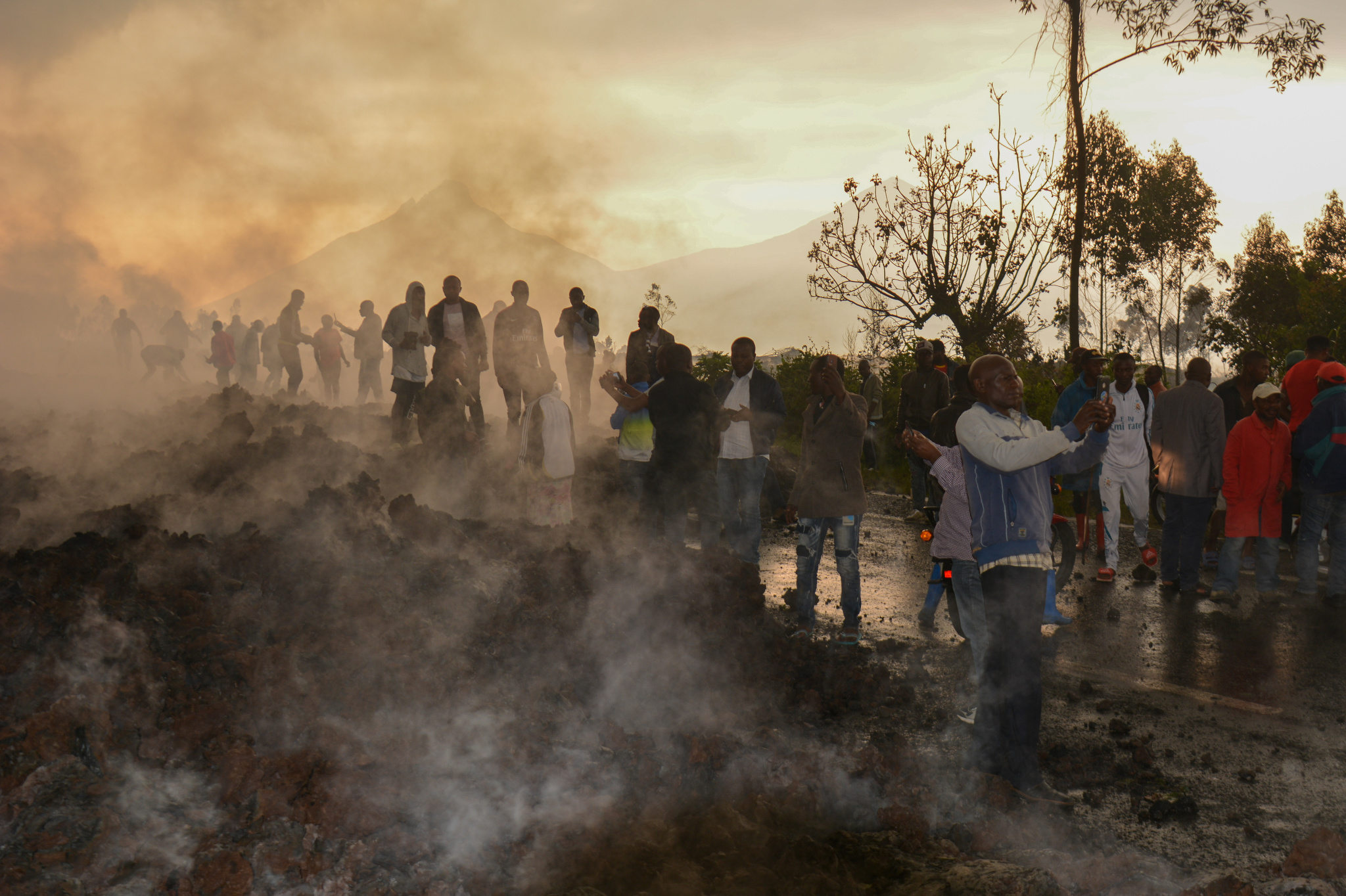
Noella Nyirabihogo, GPJ DEMOCRATIC REPUBLIC OF CONGO
Florida Baralizi fled her home when Mount Nyiragongo erupted. She now lives in a refugee camp.
GOMA, DEMOCRATIC REPUBLIC OF CONGO — In the early hours of the day, under the warm sun, Florida Baralizi sits on a rock in front of a small hut, looking sad and lost. On May 22, the eruption of Mount Nyiragongo, one of the most dangerous volcanoes in Africa, surprised Baralizi and hundreds of thousands of other residents who lived at the foot of the volcano. Everything she owned – her house, her shop, her clothes, her money, her personal documents and the field where she grew beans – was reduced to ashes.
Now, the 43-year-old lives with her four children and 400 other families in a refugee camp about 8 kilometers (5 miles) from the volcano, in the village of Bukanda, a short distance from the city of Goma.
“For a second there, I thought it was all a dream, that none of it was real,” she says. “Sadly, I was very much awake and realized I had just lost my house and everything I had that helped me to provide for my children.”
The eruption destroyed more than 3,000 homes and displaced some 400,000 people in eastern DRC. At least 31 people were killed. As people like Baralizi piece their lives back together, residents and scientists say the disastrous consequences of the eruption could have been avoided if the government’s early warning system had functioned properly.



The centerpiece of the country’s risk-mitigation program is the Goma Volcano Observatory, which the government established in 1986. After Mount Nyiragongo erupted in 2002, the GVO began monitoring two active volcanoes – Mount Nyiragongo and Mount Nyamulagira – for signs of eruptions. This early warning system was supposed to alert residents to an impending volcanic eruption two weeks before it occurred, allowing them time to evacuate. But when Mount Nyiragongo erupted again in May, there was no warning at all.
Residents and scientists accuse the GVO’s administrators of corruption and mismanagement. In June, a group of scientists working at the GVO addressed an open letter to DRC President Félix Tshisekedi in which they accused GVO administrators of misusing funds. More than $7 million from the European Union, the World Bank and other groups didn’t go to the intended projects, the scientists charged.
“Most of the funds in support of these projects were diverted and prevented many projects from going ahead,” the memo states, including public awareness campaigns, research programs and equipment purchases.
Célestin Kasereka Mahinda, the GVO’s scientific director, defends the agency against the accusations, saying the GVO had stopped receiving aid from the central government and international donors. Because of this lack of financial support, Mahinda says, Mount Nyiragongo hadn’t been monitored for seven months, from October 2020 to April 2021.
“During this whole time, we had no internet connection and were not receiving any real-time data,” Mahinda says.



In May, the GVO received additional funding from the United States, Mahinda says, which allowed it to start monitoring magmatic activity inside the volcano again. Unfortunately, there was not enough time to prepare for the imminent eruption.
“We recorded warning signs the moment we had access to the internet, but the volcano had already been displaying a high level of activity,” Mahinda says. “That’s why we were surprised by the eruption.”
At a press conference on June 5, José Panda Kabangu, the minister of scientific research, acknowledged that the government had failed to prioritize resources to the GVO, and said the observatory would receive the funding and equipment it needs going forward.
In the wake of the disaster, the government has worked to provide people with food, water and medical care. In June, Tshisekedi announced the creation of an agency that would work alongside the GVO to ensure more robust disaster prevention and management.
For many affected residents, such proposals come far too late.
“The eruption cost me everything, and life here is very difficult, especially for our children,” says Hangi Bizimungu, a father of six. “They are not eating or sleeping well.”



Bizimungu’s family is among the more than 1,000 people who have taken shelter at the Kahembe school in the Kibati groupement, a few miles from Goma. Despite the support they receive from various aid groups, living at the school has been difficult. Displaced families sleep in the classrooms at night but must leave when students arrive in the morning. They share just four toilets, which creates long lines and unsanitary conditions.
Baralizi, who was financially independent before the eruption, now spends her days waiting to receive food so she and her children can eat. Every morning and evening, she prays to have a decent house and business again.
“The president recently came to the camp and promised us that things would improve,” Baralizi says. “But one thing is clear: Life will never be the same again.”
Noella Nyirabihogo is a Global Press Journal reporter based in Goma, Democratic Republic of Congo. She specializes in covering peace and security.
TRANSLATION NOTE
Emeline Berg, GPJ, translated this article from French.






